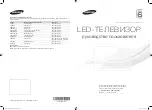
Video demodulation
The color decoder circuit detects whether the signal is a PAL, NTSC or SECAM signal. The result is made known to the auto
system manager. The PAL/NTSC decoder has an internal clock generator, which is stabilized to the required frequency by
using the 12 MHz clock signal from the reference oscillator of the microcontroller / teletext decoder.
The base-band delay line is used to obtain a good suppression of cross color effects.
The Y signal and the delay line outputs U and V are applied to the luminance / chroma signal processing part of the TV
processor.
Luminance / Chrominance signal processing
The output of the YUV separator is fed to the internal YUV switch, which switches between the output of the YUV separator
or the external YUV (for DVD or PIP) on pins 51-53. Pin 50 is the input for the insertion control signal called 'FBL-1'. When
this signal level becomes higher than 0.9 V (but less than 3 V), the RGB signals at pins 51, 52 and 53 are inserted into the
picture by using the internal switches.
Also some picture improvement features are implemented in this part:
•
Black stretch
This function corrects the black level of incoming signals, which have a difference between the black level
and the blanking level. The amount of extension depends upon the difference between actual black level and the darkest
part of the incoming video signal level. It is detected by means of an internal capacitor.
•
White stretch
This function adapts the transfer characteristic of the luminance amplifier in a non-linear way depending
on the average picture content of the luminance signal. It operates in such a way that maximum stretching is obtained
when signals with a low video level are received. For bright pictures, stretching is not active.
•
Dynamic skin tone correction
This circuit corrects (instantaneously and locally) the hue of those colors which are
located in the area in the UV plane that matches the skin tone. The correction is dependent on the luminance, saturation
and distance to the preferred axis.
The YUV signal is then fed to the color matrix circuit, which converts it to R, G and B signals. The OSD/TXT signal from the
microprocessor is mixed with the main signal at this point, before being output to the CRT board (pins 56, 57 and 58).
Picture in picture (if present)
The PIP controller M65669FP is an NTSC video processor for TV applications. It contains all of the analog signal
processing, control logic and memory, necessary to provide sub-picture insertion from a second, non-synchronized, video
source into the main picture of the TV. This can be an external source (via the rear I/O inputs) or the video signal of the
tuner.
Sync signals are derived from the sandcastle signal and separated by circuit 7171-7174 on the PIP-interface, and then fed to
pins 32 and 33 of the PIP processor 7803.
Содержание 7603 series
Страница 1: ......
Страница 5: ......
Страница 16: ...Schematic notes ...
Страница 30: ......
Страница 31: ......
Страница 32: ......
Страница 33: ......
Страница 34: ......
Страница 35: ......
Страница 36: ......
Страница 37: ......
Страница 55: ...Circuit Description Block Diagram ...
Страница 56: ...Test point overview Main Panel Test point overview CRT Panel ...
Страница 68: ...Power Supply Figure 1 ...
Страница 81: ...SCHEMATIC BLOCK BY BLOCK CIRCUIT DESCRIPTION ...
Страница 82: ......
Страница 83: ......
Страница 84: ......
Страница 85: ......
Страница 86: ......
Страница 87: ......
Страница 88: ......
Страница 89: ......
Страница 90: ......
Страница 91: ...24M8 7603 ...
Страница 92: ...24M8 7603 ...
Страница 93: ...24M8 7603 ...
Страница 94: ...24M8 7603 ...
Страница 95: ...All Models 7603 Chassis Overview ...
Страница 96: ...All Models 7603 Power Supply Diagram A1 ...
Страница 97: ...All Models 7603 Line Deflection Diagram A2 ...
Страница 98: ...All Models 7603 Frame Deflection Diagram A3 ...
Страница 99: ...All Models 7603 Tuner IF Diagram A4 ...
Страница 100: ...All Models 7603 Video IF And Sound IF Diagram A5 ...
Страница 101: ...All Models 7603 Synchronization Diagram A6 ...
Страница 102: ...All Models 7603 Control Diagram A7 ...
Страница 103: ...All Models 7603 Audio Amplifier Diagram A8 ...
Страница 104: ...All Models 7603 BTSC Stereo SAP Decoder Diagram A9 ...
Страница 105: ...All Models 7603 Audio Video Source Switching Diagram A10 ...
Страница 106: ...All Models 7603 BTSC NDBX Stereo Decoder Diagram A11 ...
Страница 107: ...All Models 7603 Front I O Control Headphone Diagram A12 ...
Страница 108: ...All Models 7603 Rear I O Cinch Diagram A13 ...
Страница 109: ...All Models 7603 PIP Interface Diagram A16 ...
Страница 110: ...All Models 7603 CRT Panel Diagram B1 ...
Страница 111: ...All Models 7603 Side AV Headphone Panel Diagram C ...
Страница 112: ...All Models 7603 Side AV Headphone Panel Diagram E1 ...
Страница 113: ...All Models 7603 PIP Panel Diagram P ...
Страница 114: ...All Models 7603 Top Control Panel Diagram T ...
Страница 115: ...All Models 7603 SCAVEM Diagram B2 ...
Страница 116: ...All Models 7603 PCB Large Signal panel component side ...
Страница 117: ...All Models 7603 PCB Large Signal panel copper side ...
Страница 118: ...All Models 7603 PCB CRT panel component side ...
Страница 119: ...All Models 7603 PCB CRT panel copper side ...
Страница 120: ...All Models 7603 PCB Side AV Panel component side ...
Страница 121: ...All Models 7603 PCB Side AV Headphone Panel component side ...
Страница 122: ...All Models 7603 PCB PIP Panel component side ...
Страница 123: ...All Models 7603 PCB PIP panel copper side ...
Страница 124: ...All Models 7603 PCB Top control round component side ...
Страница 125: ...All Models 7603 PCB Top control round copper side ...
Страница 126: ...All Models 7603 PCB Top control oval component side ...
Страница 127: ...All Models 7603 PCB Top control oval copper side ...
Страница 128: ...MAIN CABINET EXPLODED VIEW ...
















































